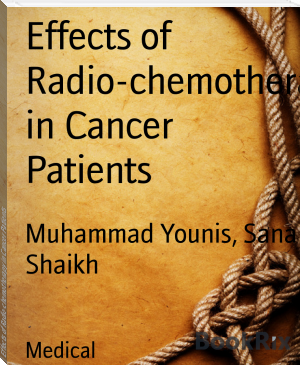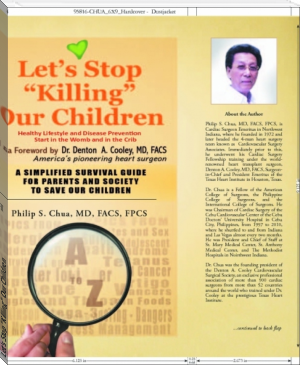Effects of Radio-chemotherapy in Cancer Patients, Muhammad Younis, Sana Shaikh [top ten ebook reader txt] 📗

- Author: Muhammad Younis, Sana Shaikh
Book online «Effects of Radio-chemotherapy in Cancer Patients, Muhammad Younis, Sana Shaikh [top ten ebook reader txt] 📗». Author Muhammad Younis, Sana Shaikh
Chemotherapy, also called chemo, is medicines used to treat cancer. These medicines destroy cancer cells, keep them from growing and spreading, shrink the size of a tumor or relieve cancer symptoms. [60] It is well known that reducing the chemotherapy dose reduces the response rate and does not cure cancer.[61] The term, 'Chemotherapy,' is a general one used in association with any treatment involving the use of chemical agents to stop cancer cell growth. Chemotherapy may eliminate cancerous cells at sites that are at great distances from the original site of cancer development. Because of this, chemotherapy is considered to be a form of systemic treatment. Greater than half of all persons who have been diagnosed with cancer receive chemotherapy. Chemotherapy assists in treating millions of people successfully, helping them to enjoy full and productive life. [45]
The goal of Chemotherapy
Keep cancer from spreading Slow cancer's growth Kill cancer cells that may have spread to other parts of the body from the original tumor relieve symptoms caused by cancer.[62]How does chemotherapy work?
Chemotherapy involves taking drugs that kill cells that are dividing rapidly such as cancer cells. The most common way of having chemotherapy is by injection into a vein (intravenously or IV), but sometimes chemotherapy drugs are taken as tablets. IV treatment involves the drug being administered through a vein in the hand or arm. Some women have chemotherapy that is a combination of tablets and IV. Chemotherapy drugs are absorbed into the blood and travel through the body finding and destroying the remaining cancer cells. [63]
How is chemotherapy given?
Chemotherapy may be given in many ways.
Injection. The chemotherapy is given by a shot in a muscle in your arm, thigh, or hip or right under the skin in the fatty part of your arm, leg, or belly. Intra-arterial (IA). The chemotherapy goes directly into the artery that is feeding cancer. Intraperitoneal (IP). The chemotherapy goes directly into the peritoneal cavity (the area that contains organs such as your intestines, stomach, liver, and ovaries). Intravenous (IV). The chemotherapy goes directly into a vein. Topically. The chemotherapy comes in a cream that you rub onto your skin. Orally. The chemotherapy comes in pills, capsules, or liquids that you [63]Cancer Chemotherapy -- Effectiveness by Disease:
Curative Acute Lymphocytic Leukemia, Hodgkin’s Disease, Diffuse Histiocytic Lymphoma, Burkitt’s Lymphoma Testicular Cancer, Choriocarcinoma Wilms’ Tumor, Ewing’s Sarcoma, Embryonal Rhabdomyosarcoma Probably Curative Acute Myelogenous Leukemia Small Cell Lung Cancer, Breast Cancer, Osteogenic Sarcoma Major Therapeutic Benefit (Short of Cure) Head and Neck Cancer, Cervical Cancer, Metastatic Breast Cancer, Ovarian Cancer Soft Tissue Sarcoma Nodular Lymphomas, Chronic Leukemia’s Insulinomas Limited Effectiveness Lung Cancer GI Cancer Prostate Cancer Melanoma. [64]Types of chemotherapy: It’s rather confusing and pointless most of the time to go through all the types of chemotherapy, but there are people who find such a list both informative and useful. It includes alkylating agents’ chemotherapy, alkaloid-based treatment, anti-tumor antibiotics, antimetabolites, topoisomerase inhibitors, antineoplastics and so on. [65]
1: Antimetabolites
Mechanisms
incorporation of nucleotide analog in DNA or RNA, resulting in abnormal nucleic acids inhibition of certain enzymes involved in nucleotide biosynthesis.[64] These drugs either purine or either pyramidin[65] Examples: 1: Pyrimidines Uracil: 5-fluorouracil (5-fluoro-2’-deoxyuridine) Thymine: 3’-azido-3’-deoxythymidine Cytosine: Cytosine arabinoside; 5-azacytidine 2: Purines Adenine: 6-mercaptopurine Guanine: 6-thioguanine 3: Antifols (Methotrexate): competitive inhibition of dihydrofolate reductase, necessary for the generation of methyl donors required for thymidine synthesis.[64][65]
Toxicity (general)
interfere with replication of all rapidly proliferating cells bone marrow --- myelosuppression GI mucosa ---- diarrhea, stomatitis Toxicity (specific) 6-mercaptopurine --- cholestatic jaundice Methotrexate renal – high doses may block tubules and cause acute renal failure hepatic – usually seen with chronic daily administration of low doses (i.e., psoriasis treatment) CNS – encephalopathy in patients given prior irradiation.[64]
2: Plant Alkaloids:
Vincristine, vinblastine, taxanes. All are plant alkaloids that cause mitotic arrest by poisoning the spindles.Mitotic spindles are vital for cell division.[65]
Toxicity
neurotoxicity paresthesias constipation decreased deep tendon reflexes myelosuppression.[64]3:Alkalyting agents:
Mechanisms
Base alkylation resulting in DNA cross-linking Single-strand breaks Double-strand breaks and strand misreading.[64] Examples: Nitrogen Mustard Cyclophosphamide Nitrosoureas Cis-platinum Busulfan,melphalan.[64][65] Toxicities (general) Myelosuppression Stomatitis Nausea/vomiting Alopecia Impaired ovulation and spermatogenesis Mutagenesis and carcinogenesis. [64] 4: Antibiotics Mechanism cause linking of double strands of DNA and prevent replication. Examples Adriamycin, bleomycin, epirubicin.[65]5:Anthracyclines :
Mechanisms
Intercalate between strands of DNA double helix Formation of drug-free radicals Inhibition of topoisomerase II Examples: Daunorubicin Doxorubicin (Adriamycin) Toxicities Myelosuppression Stomatitis Cardiotoxicity (irreversible, dose-related).[64] 6:L-Asparginas (E. Coli,erwentia)Mechanisms
l-asparaginase converts asparagine to aspartate and NH3. Normal cells can reverse this process to form asparagine. The drug has activity in acute lymphocytic leukemia. Lymphoblasts lack asparagine synthetase and die without preformed asparagine in plasma.
Toxicity
Hypersensitivity (urticaria, anaphylaxis) Pancreatitis Hepatotoxicity.[64] 7: Podophyllotoxin: Mechanism This is a plant-derived compound that is used to producedcertain drugs. They prevent the cell from entering the S phase of the cell cycle.
Examples
Etoposide and Teniposide. [65]
8: Corticosteroids:
Mechanisms
• Unclear –induce apoptosis of lymphoblasts and effective in lymphoid malignancies
• Work via nuclear receptors
Examples
• Prednisone
• Dexamethasone
Toxicity
• Typical steroid toxicity –relatively modest in this context. [64]
9: Platinum compounds
Mechanism
They are alkylating agents and they form cross-linkage adducts thus blocking DNA replication.
Examples
Cisplatin, Carboplatin.[65]10: Anthracyclines
Mechanisms
Intercalate between strands of DNA double helix Formation of drug-free radicals Inhibition of topoisomerase IIExamples:
Daunorubicin Doxorubicin (Adriamycin) Toxicities Myelosuppression Stomatitis Cardiotoxicity (irreversible, dose-related). [64]Side effects of chemotherapy:
Chemo can destroy or slow down the growth of normal cells, including cells of the hair, mouth, digestive system, and bloodstream. [59] Chemotherapy is designed to kill fast-growing cancer cells. But it can also affect healthy cells that grow quickly. These include cells that line your mouth and intestines, cells in your bone marrow that make blood cells, and cells that make your
hair grow. Chemotherapy causes side effects when it harms these healthy cells.[63] By understanding the most common chemotherapy side effects—and by taking action to protect against possible outcomes—the chance of experiencing some serious side effects may be decreased.[66]
Nausea and Vomiting:
It is quite common to feel nausea when having chemotherapy. Nausea can last for a few hours to a few days. Chemotherapy can also make some women vomit. The good news is that nausea and vomiting can usually be controlled with drugs called anti-emetics.
Fatigue:
Feeling tired is one of the main side effects of chemotherapy, and can last 3-6 months after your treatment is finished. Fatigue can also be due to anemia, which means that there are fewer red blood cells in your blood. [62][63]
Hair Loss
Hair loss from chemotherapy can range from mild thinning of the hair to total hair loss (including body hair).
Not all chemotherapy drugs cause hair loss. If you do lose some hair it will usually grow back within weeks.
Diarrhea and constipation:
This can be from chemotherapy drugs, or from being less active or eating less due to nausea. Some anti-nausea drugs can also cause constipation. [59][62][63]
Weight gain or loss:
Some having chemotherapy lose their appetite and lose weight, while others put on weight.
Depression:
Some feel depressed, sad or teary before, during and after chemotherapy treatment. Some sadness or depression is normal.
Anxiety:
Some feel anxious, worried, nervous or distressed before, during and after treatment. Some anxiety is normal. [62]
Anemia:
Anemia can make you feel short of breath, weak, dizzy, faint, or very tired.
Some types of chemotherapy cause anemia because they make it harder for the bone marrow to produce new red blood cells. [63][66]
Appetite Changes:
Chemotherapy can cause appetite changes. You may lose your appetite because of nausea (feeling like you are going to throw up), mouth and throat problems that make it painful to eat, or drugs that cause you to lose your taste for food. [63]
Bleeding:
Platelets are cells that make your blood clot when you bleed. Chemotherapy can lower the number of platelets because it affects your bone marrow’s ability to make them. A low platelet count is called thrombocytopenia. This condition may cause bruises (even when you have not been hit or have not bumped into anything), bleeding from your nose or in your mouth, or a rash of tiny, red dots. [59][63]64]
Infection:
Some types of chemotherapy make it harder for your bone marrow to produce new white blood cells. White blood cells help your body fight infection. Therefore, it is important to avoid infections, since chemotherapy decreases the number of your white blood cells.[59][63][66]
Infertility:
Some types of chemotherapy can cause infertility. [63]
Mouth and Throat Changes:
Some types of chemotherapy harm fast-growing cells, such as those that line your mouth, throat, and lips. This can affect your teeth, gums, the lining of your mouth, and the glands that make saliva. Most mouth problems go away a few days after chemotherapy is over.
Pain:
Some types of chemotherapy cause painful side effects. These include burning, numbness, and tingling. [59][63]
the Side effects of chemotherapy:
Skin or nail changes or reactions
Menopausal symptoms (temporary or permanent)
Sexual difficulties
Nerve and muscle problems
Swelling in the arms and legs.
The following side effects of chemotherapy are rare but can be quite serious (medical advice should be sought if any of the following occur):
Bleeding or bruising
Kidney or bladder problems
Heart problems
Bone marrow problems. [67]
MATERIAL AND METHODS
Present work was conducted to investigate the effect of radiotherapy and chemotherapy in cancer patients. In which we carried biochemical analysis (RBC’s, WBC’s, platelets, Hb, MCV, MCH, MCHC, TLC, neutrophils, basophils, eosinophils, lymphocyte, and monocyte), physiological and anthropometric measurements.
2.1 Sample collection:
Eighty samples were collected. Out of them, forty were cancer patients and forty are normal subjects. A cancer patient was selected from the Nuclear Institute of Medicine and Radiotherapy (NIMRA), Jamshoro. The age group of samples as well as control was between 25-50 years.
2.2 Anthropometric Measurement:
The field of anthropometry encompasses a variety of human body measurements, such as weight, height, and size, including circumferences, lengths, breadths, and skinfold thicknesses. Anthropometry is a key component of nutrition status assessment in children and adults. Anthropometric data for children reflect general health status, dietary adequacy, and growth and development over time. In adults, body measurement data are used to evaluate health and dietary status, disease risk, and body composition changes that occur over the adult lifespan. [68] We carried two types of anthropometric measurement, height and weight. Height done by tap measurement and weight is





Comments (0)